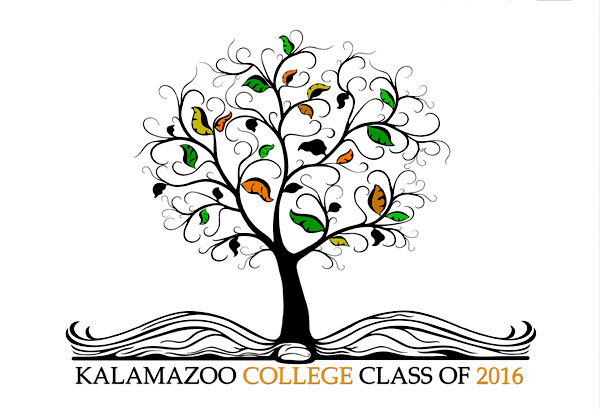Kalamazoo College President Jorge G. Gonzalez reflected today on the state of the College and highlighted the contributions of its students to the Kalamazoo community and the reciprocal benefits that result from local partnerships at K’s annual Community Breakfast. In attendance were local and state officials, business and community leaders and area educators representing more than 50 organizations and institutions.
After an introduction from Kalamazoo College Board of Trustees member Kevin E. Jawahir ’92, Gonzalez spoke about the College’s diverse enrollment, including the increasing number of first-generation college students. Gonzalez said that Kalamazoo College continues to bring in exceptional classes of students from around the U.S. and the world. This year, the College welcomed 370 first-year students and 11 transfer students from 21 states and 13 countries. Of these, he noted, 38 percent are domestic students of color, 28 percent are from families of modest means (Pell Grant eligible) and 30 percent are first-generation students.
He went on to describe how, through a variety of programs and initiatives, Kalamazoo College students become integral members of the local community during their time here, creating a profound and positive impact that extends beyond the campus borders. In return, students acquire valuable skills, develop a heightened sense of civic engagement, and establish relationships that lead to future career opportunities and a deep connection to the city.
“Kalamazoo College is a talent importer,” Gonzalez said. “Wherever students come from, once they are on campus, they inevitably become part of the fabric of life in Kalamazoo. They work for local employers and nonprofits, they volunteer and work in local schools, and they spend money in local businesses. After experiencing everything that K and Kalamazoo has to offer, some of our students choose to stay and build a life in the Kalamazoo area.”
He noted that an important element of the student experience at K is the partnership between the College and local organizations. Gonzalez cited the work of the Mary Jane Underwood Stryker Center for Civic Engagement, the Larry J. Bell ’80 Environmental Stewardship Center, the Arcus Center for Social Justice Leadership and the Center for Career and Professional Development—all of which provide student-led programming, service-learning opportunities, and connections to employment in the Kalamazoo area.
These opportunities would not be possible, Gonzalez said, without gifts and grants from alumni, friends, corporate donors and community foundations, which support programming and provide stipends and funding for students with financial need.
Such gifts have also advanced The Brighter Light Campaign, which the College launched publicly in 2021. The campaign has raised $181 million against its original $150 million goal. The College recently announced that it was raising the goal to at least $190 million, in honor of the institution’s 190th anniversary.
After Gonzalez’s remarks, junior biochemistry and music major Isabella Pellegrom spoke about her experiences at K, focusing on her scientific research and her involvement in K’s music ensembles.
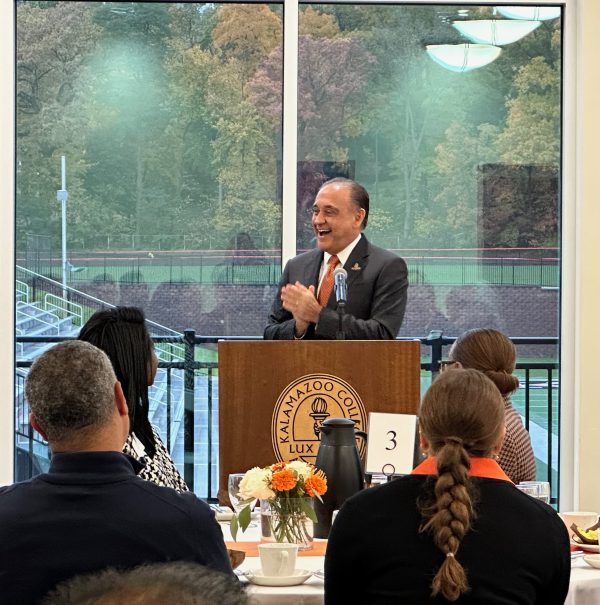
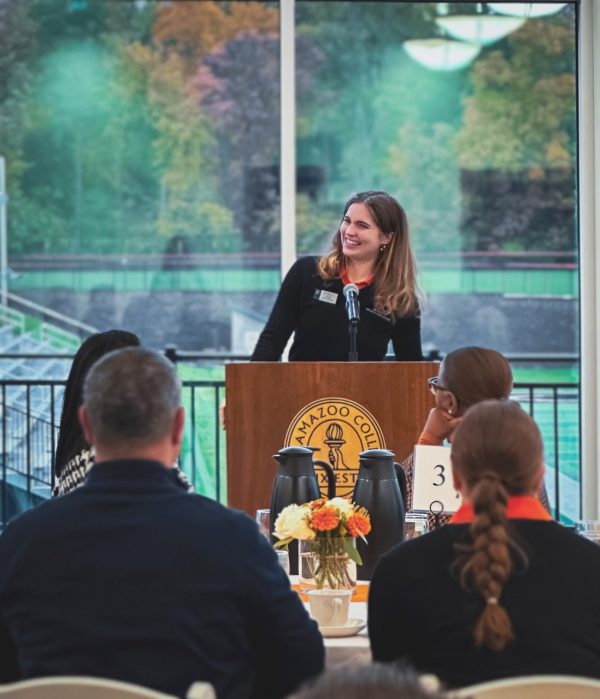
At K, Pellegrom had the opportunity to participate in inorganic chemistry research with Assistant Professor of Chemistry Daniela Arias-Rotondo, synthesizing manganese and zinc crystals. She also completed a summer clinical research program at the Institute for Exercise and Environmental Medicine at the University of Texas Southwestern. As a musician, Pellegrom is a member of the Academy Street Winds, the Kalamazoo Jazz Band, the College Singers and the Limelights a cappella group.
Hailing from Minnesota and having parents who attended K, as well as relatives from Kalamazoo, Pellegrom said, “My deep roots in Kalamazoo brought me to K, and since arriving I have found opportunities to deepen my connections to this city, discovering more about myself along the way.” Of her many accomplishments, she said, “Three years ago, I wouldn’t have thought any of these feats possible. But now, I am unafraid to be ambitious because, above all that I’ve learned in my time at Kalamazoo College, the most important has been the ability to believe in myself. So, though I can’t see into my future, I know the future holds great things for me because, like my family, now I too am rooted in Kalamazoo.”


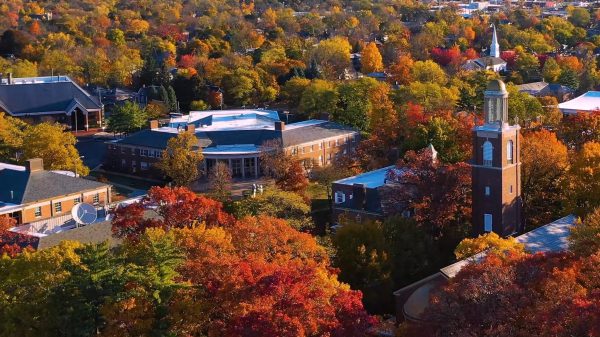
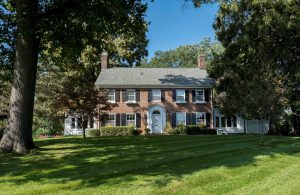
 The tension between what is politically possible under the world’s current political and economic systems and what is ecologically necessary exposes an urgent need for change, said journalist and activist Naomi Klein, keynote speaker for the conference, “Without Borders, Post-Oppression Imaginaries and Decolonized Futures.” The conference was sponsored by the
The tension between what is politically possible under the world’s current political and economic systems and what is ecologically necessary exposes an urgent need for change, said journalist and activist Naomi Klein, keynote speaker for the conference, “Without Borders, Post-Oppression Imaginaries and Decolonized Futures.” The conference was sponsored by the  Nora Naranjo Morse will deliver the annual Phi Beta Kappa lecture at Kalamazoo College on Tuesday, October 11, at 8 p.m. in the Mandelle Hall Olmsted Room. The event is free and open to the public. Morse Morse is a sculptor, writer, and producer of video films that look at the continuing social changes within Pueblo Indian culture. Her talk, “Numbe Wahgeh,” focuses on the historical treatment of the Pueblo people and history retold by indigenous peoples.
Nora Naranjo Morse will deliver the annual Phi Beta Kappa lecture at Kalamazoo College on Tuesday, October 11, at 8 p.m. in the Mandelle Hall Olmsted Room. The event is free and open to the public. Morse Morse is a sculptor, writer, and producer of video films that look at the continuing social changes within Pueblo Indian culture. Her talk, “Numbe Wahgeh,” focuses on the historical treatment of the Pueblo people and history retold by indigenous peoples. Kalamazoo College kicks off the 2016-17 academic year on Wednesday September 7 at 3 p.m. with its annual opening convocation ceremony for new students ready to begin their liberal arts adventure.
Kalamazoo College kicks off the 2016-17 academic year on Wednesday September 7 at 3 p.m. with its annual opening convocation ceremony for new students ready to begin their liberal arts adventure. Be Light, indeed! After a 30-some-year absence, stadium lights once again light Angell Field, home to the Kalamazoo College Hornet football team. With help from Musco Sports Lighting and Hi-Tech Electric, K is now the first sports stadium in Michigan with LED lights designed to drastically reduce both light trespass and glare outside the College’s property lines. Musco engineers, a City of Kalamazoo inspector, K officials and several neighbors witnessed a test of the lighting system at its highest intensity Wednesday night. All pronounced the finished product a success. K and its lighting consultants will continue to tweak the lights in order to achieve maximum benefit on the field and off. Per an agreement with neighbors and the City, K will use the lights for up to 20 nights annually, almost exclusively for practices that will accommodate Hornet varsity football, men’s and women’s soccer, men’s and women’s lacrosse, men’s and women’s club ultimate Frisbee and intramural teams. (Wednesday’s test counted as one of those 20 nights.) Thank you, everyone, who worked hard to bring lights back to Angell Field. Lux esto! (text by Jeff Palmer; photo by Susan Andress)
Be Light, indeed! After a 30-some-year absence, stadium lights once again light Angell Field, home to the Kalamazoo College Hornet football team. With help from Musco Sports Lighting and Hi-Tech Electric, K is now the first sports stadium in Michigan with LED lights designed to drastically reduce both light trespass and glare outside the College’s property lines. Musco engineers, a City of Kalamazoo inspector, K officials and several neighbors witnessed a test of the lighting system at its highest intensity Wednesday night. All pronounced the finished product a success. K and its lighting consultants will continue to tweak the lights in order to achieve maximum benefit on the field and off. Per an agreement with neighbors and the City, K will use the lights for up to 20 nights annually, almost exclusively for practices that will accommodate Hornet varsity football, men’s and women’s soccer, men’s and women’s lacrosse, men’s and women’s club ultimate Frisbee and intramural teams. (Wednesday’s test counted as one of those 20 nights.) Thank you, everyone, who worked hard to bring lights back to Angell Field. Lux esto! (text by Jeff Palmer; photo by Susan Andress) Kalamazoo College once again is included in the annual “Fiske Guide to Colleges,” a popular and useful resource for high school students and their families researching prospective colleges, compiled by former New York Times education editor Edward B. Fiske, a top independent voice in college admissions.
Kalamazoo College once again is included in the annual “Fiske Guide to Colleges,” a popular and useful resource for high school students and their families researching prospective colleges, compiled by former New York Times education editor Edward B. Fiske, a top independent voice in college admissions.
